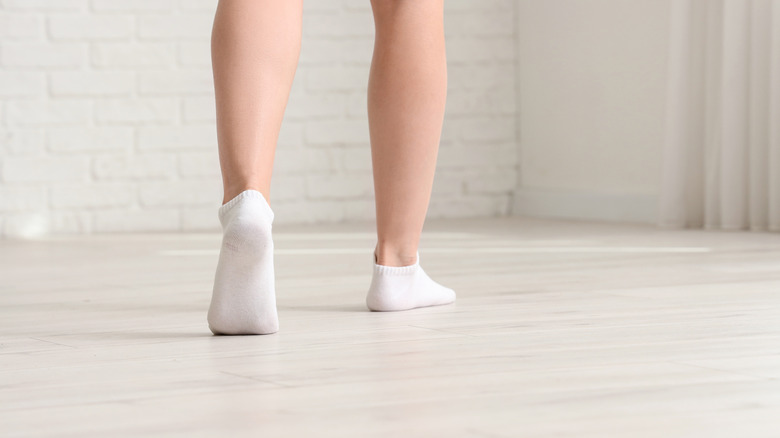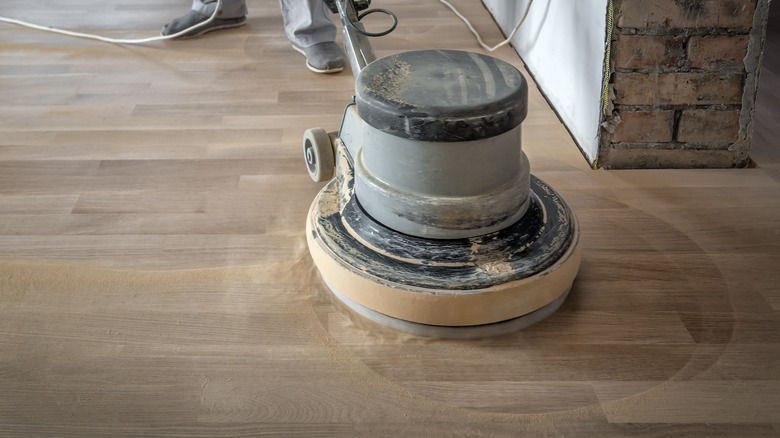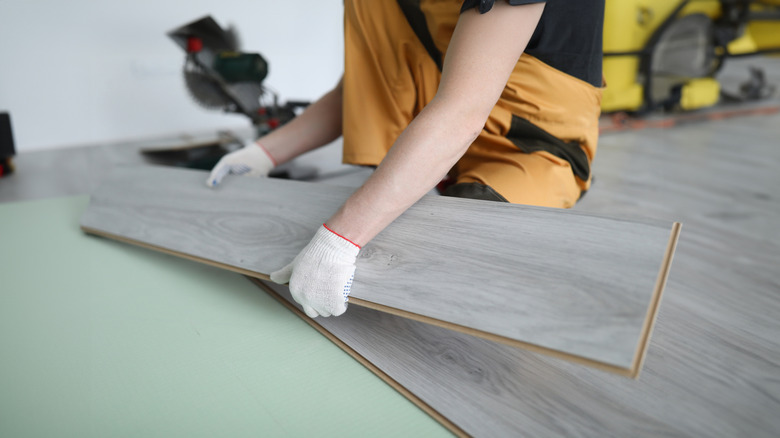Things You Should Never Do If You Have Laminate Floors
Laminate flooring is valued for its durability, style, and its low cost compared to other types of floors: Not only will it cost less than hardwoood floors, but it will last longer, with less scratches. While the sturdy composition of laminate makes for a pretty tough floor, though, it is still very possible to damage it — even with seemingly innocuous tasks like cleaning it the wrong way.
Laminate doesn't play well with abrasive cleaning surfaces. It's also more susceptible to water damage, and it doesn't tolerate polishes, oils, and certain cleaning agents you might use on other types of floors ... and that's just the start of it. So whatever your laminate situation — whether you have recently moved into a home with laminate flooring, or you've just installed a brand-new laminate floor, or it's just an upgrade you're considering — it's important to be aware of the things you should never do if you want it to last.
Sanding laminate floors can create permanent damage
Due to its durability, laminate is often especially appealing for families with pets and children. The fact that it's less scratch-prone than hardwood flooring, though, doesn't mean that laminate doesn't get damaged from time to time (note that it still contains some wood, too). You may be tempted to sand such signs of damage to recreate a smooth floor.
Stop yourself right there. Be warned that sanding isn't typically recommended for laminate floors because of the risk of damage to the top layer, which is considerably thin. If you do have damaged sections, skip the sanding and consider just replacing that small area instead.
To be clear, there are situations where it's possible to get away with some sanding — but even then, it's a whole different beast (and a far riskier one) than with wood floors. Know in advance that sanding is not going to get you the clean new surface you get with wood, but it can smooth out a few scratches and make them slightly less visible ... as long as you don't sand too hard, and make a bigger problem out of it. Such a procedure should only be taken with extreme caution, a very fine sandpaper, and the application of a laminate reviver afterward.
Don't spill too much water on your laminate flooring
The process of mopping, as we all know, traditionally consists of a bucket of water with a cleaning agent. However, unlike other types of flooring, laminate cannot withstand too much water. Whether you're soaking the floors as part of your mopping process or spilling cups of water and leaving them, excess water that isn't taken care of can rapidly ruin laminate floors, cause mold growth underneath, and lead to streaks.
While you don't have to avoid using water entirely, the key is to make sure intentional exposure is kept to small amounts at a time. As a rule of thumb, use small amounts of water with a damp mop when you're deep cleaning your floors, and be sure to follow up with a dry cloth. Do this every couple of months. Also, if you have laminate floors in your kitchen, bathroom, or around planters and water bowls for pets, be sure to clean any spilled water promptly. Otherwise, prolonged contact with water can cause permanent damage.
Don't rely on the wrong cleaners for laminate flooring
Just as it's important to avoid saturating your floors with water, you'll also want to take care not to use commercial cleaners that aren't suitable for laminate flooring. Using just any old cleaning solution could get rid of stains and spills, but you may also be left with damage in their wake. You should especially avoid cleaning agents that contain oil, abrasive materials, or ammonia.
When using commercial cleaners for your floors, be sure the label specifically indicates the product is safe for laminate flooring. One example is Bona Multi-Surface Floor Cleaner Spray. On the flip side, you may not really have to use commercial cleaners at all. Deep cleaning a laminate floor really only requires a spray bottle of soapy water, which you can use in small amounts with a microfiber cloth. Alternatively, you can use small amounts of diluted rubbing alcohol or white vinegar and spray these on a mop to clean stains and dried-on messes. Not only will you save money and time, but you won't risk damaging the floors.
Don't vacuum laminate flooring as you would with carpeted floors
Before you mop any surface, it's a good idea to clean up any dirt, dust, and debris so you aren't spreading it around the floor. Not only does this make mopping more effective, but it also reduces the risk of scratches from any of these materials on your laminate floors. For clean hard surfaces, many people opt for vacuuming over sweeping, but while you can still vacuum laminate flooring, you need to do so with care. If you simply vacuum this type of hard surface in the same manner as carpeting or rugs, it could end in floor damage.
When vacuuming laminate flooring, first be sure to turn off the beater bar, if you have one. You'll still get some of the suction power from the vacuum itself, but without all the scratches the bar may be liable to create. Another option is to invest in a device specifically designed for hard floors, such as the Kenmore DS1020 cordless vacuum. This way, you can ensure minimal damage to laminate during vacuuming sessions, without having to worry whether you remembered to turn off the beater bar or not. Also, be sure to vacuum high-traffic areas every day, to help keep particle-caused scratches at a minimum.
Don't use abrasive mops and brooms on laminate
Another common mistake to avoid when you have laminate flooring care has to do with the types of cleaning tools you have — specifically, abrasive mops and traditional bristle brooms. Even if you use such items gently, you could risk creating permanent scratches in the floor. The potential damage can be worsened by dragging dirt and debris as you sweep and clean.
For the sake of your laminate floors, you should use soft, microfiber materials and sponges only. If you do use a broom, be sure it has soft bristles and an angled head to effectively remove debris from floor crevices. Swiffer dusters and mopping kits are always a safe bet to use for laminate floors, as well, since their soft cloths won't scratch this type of flooring. The dry and wet cloths are also disposable, which nicely reduces the need to clean any accessories.
Neglecting to protect your laminate floors from furniture, toys, pets, & other household items will come back to bite you
As they say, prevention is the best medicine. Over time, laminate can succumb to wear and tear, just like any other floor. Cleaning technique can contribute to scratches, as we've covered, but it's arguably even more important to consider your family's everyday activities, and how they may weaken laminate flooring, as well. By not protecting laminate floor from these factors, you could end up with significant damage. Among some of the most common sources of scratches to consider include your furniture, children's toys, footwear, and pet nails.
Before you banish all household activity for the sake of protecting your laminate floors, know that there are steps you can take to protect the laminate without diminishing your family's lifestyle. For high-traffic areas, consider using non-slip area rugs or runners as modes of protection, while also adding a bit of style and color to the room. Door mats can also capture dirt and other scratching particles. Always attach furniture pads or sliders to act as barriers between your furniture legs and the floor. Try to limit the use of certain children's toys on laminate, such as those with wheels, and encourage your family and guests to take their shoes off by the front door. Finally, if you have pets, consider regular nail trims to keep both them and your laminate floors in good shape.
Don't avoid timely laminate floor replacements
In an ideal world, you've taken all the right steps to preserve your laminate floors. However, life happens. And life includes spills, scratches, and stains, no matter what safeguards you take. That means that, yes — at least, every once in a while — you should be replacing sections of your laminate floor.
On average, laminate flooring can last 15 to 25 years with proper maintenance. If they are not taken care of though, the reality is laminate may only last 10 years. Consider these timelines as points of reference if you're thinking about laminate floor replacements. If you're seeing deep scratches, warped boards, or signs of serious sun damage, now may be time to replace those damaged areas. That said, replacing boards on laminate flooring is a far easier process than replacing sections of other flooring types — and ease and affordability are why you picked laminate, right? — so there's nothing to fear here.







